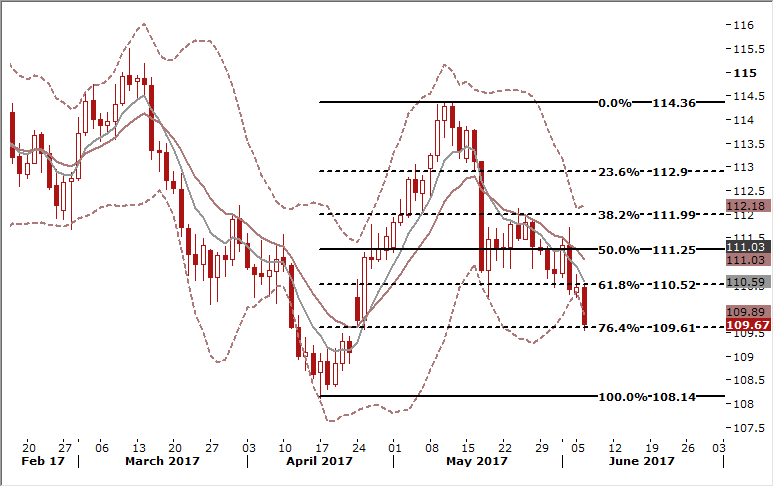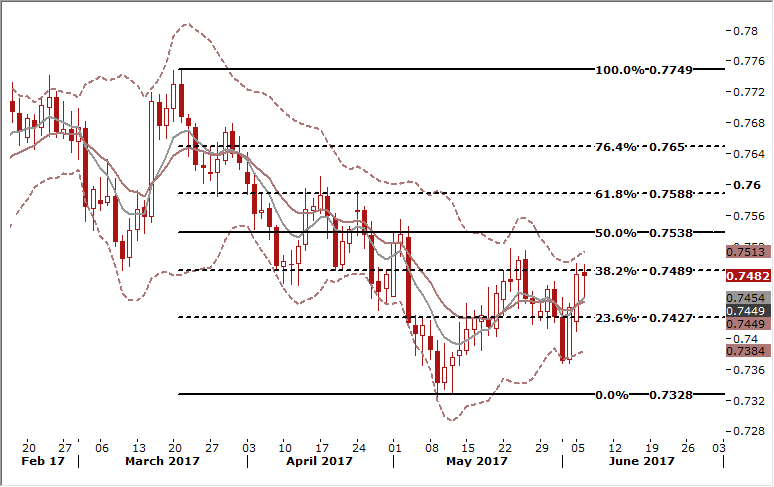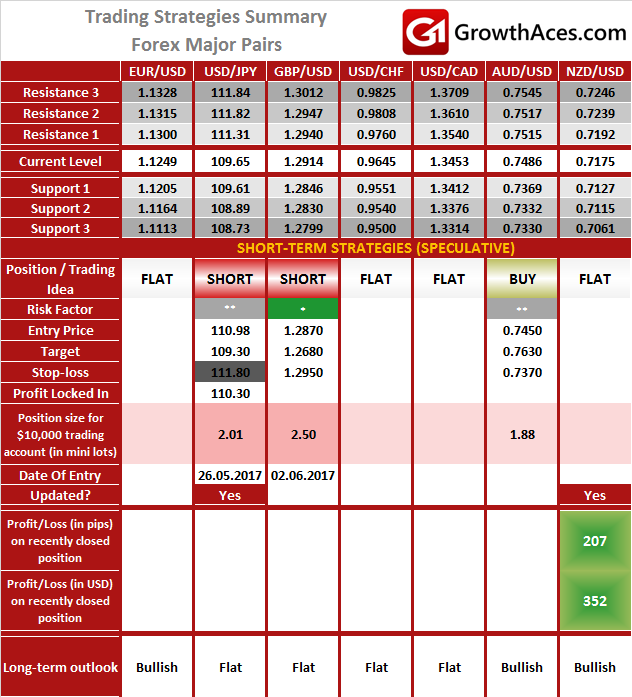USD/JPY short is getting closer to its target
Macroeconomic overview:
The ISM said its U.S. non-manufacturing activity index fell six-tenths of a percentage point to a reading of 56.9, slightly below market expectations.
In a separate report on Monday, the Commerce Department said factory goods orders dropped 0.2% in April after jumping 1.0% in March. Orders rose 4.4% from a year ago. A third report from the Labor Department showed nonfarm productivity, which measures hourly output per worker, was unchanged in the last quarter. It was previously reported to have declined at a 0.6% annualized pace. Productivity has increased at an average annual rate of 0.6% over the last five years, below its long-term rate of 2.1% from 1947 to 2016.
The moderation in services industries production, together with other data on Monday showing orders for manufactured goods falling in April for the first time in five months and worker productivity unchanged in the first quarter, suggest limited scope for faster economic growth. The dollar hit a six-week low against the safe-haven yen on Tuesday, with investors cautious ahead of Britain's election, a European Central Bank meeting and former FBI Director James Comey's testimony to a Senate committee this week.
The greenback has been firmly on the defensive since Friday's weaker-than-expected U.S. non-farm payrolls report prompted investors to pare back expectations of future interest rate increases by the Federal Reserve. Comey, the FBI director fired by U.S. President Donald Trump in May, will be grilled by the Senate Intelligence Committee on whether Trump tried to get him to back off an investigation into alleged ties between the president's 2016 campaign and Russia.
In Britain, the latest opinion poll by Survation for ITV (LON:ITV) television showed Prime Minister Theresa May's lead over the opposition Labour Party holding at just 1 percentage point ahead of Thursday's election.
Technical analysis: The USD/JPY continues to spiral lower. It is testing a support level of 109.61 (76.4% fibo of April-May rally) today. Tenakan and kijun lines are negatively aligned, reinforcing the overall bearish structure. Our short trade is getting closer to the target. 
Short-term signal: Short in good shape, profit locked in at 110.30.
Long-term outlook: Flat
AUD/USD: RBA sticks to upbeat tone
Macroeconomic overview: The Reserve Bank of Australia kept rates at a record low 1.50% in a widely expected move after last easing in August of 2016.
It cited a stabilisation in mining investment after years of steep falls, a rebound in the price of Australia's top exports of iron ore and coal, and the country's biggest-ever home building boom. "Looking forward, economic growth is still expected to increase gradually over the next couple of years to a little above 3%," the RBA said in a statement.
Policy makers also played down the importance of first-quarter GDP figures due on Wednesday, which are likely to show the economy had barely grown. We expect GDP growth of 0.2% qoq. The RBA described the job market as "mixed" with stronger employment growth offset by softness in hours worked and high levels of underemployment.
Data out on Tuesday showed government spending had added only marginally to growth in the quarter, restrained in part by persistent budget deficits.
Also weighing on real growth was a drop in export volumes, while imports swung higher. As a result, net exports trimmed a larger-then-expected 0.7 percentage points from growth, leading some investors to revise down their forecasts for GDP.
The country's current account deficit did narrow to its smallest in more than 15 years at AUD 3.1 billion, though that disappointed hopes for a rare surplus. The main miss came from investment income with Australians earning less from their assets abroad. Yet the figures from the Australian Bureau of Statistics showed a barnstorming performance by commodity exports which boosted the surplus on goods and services to AUD 9.0 billion. That was easily the biggest surplus since the series began in 1959 and owed much to higher prices for iron ore and coal, though those have come off their peaks in the last month or so. The sharp improvement in the country's perennial deficit with the rest of the world should make it less vulnerable to swings in investor sentiment. It also lessens one threat to Australia's top credit rating, which has been under pressure from persistent budget shortfalls at home. Standard & Poors recently affirmed the rating at triple-A after spending months warning that a downgrade might be warranted.
Technical analysis: AUD/USD rally from the June 1 low extends and 7-day exponential moving average gets pierced. RSIs are biased up so the upward move is likely to be continued. 
Short-term signal: Buy at 0.7450
Long-term outlook: Bullish
TRADING STRATEGIES SUMMARY:
FOREX - MAJOR PAIRS: 
Source: GrowthAces.com - your daily forex trading strategies newsletter
